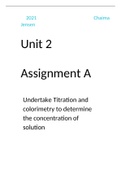2021 Chaima
Jensen
Unit 2
Assignment A
Undertake Titration and
colorimetry to determine
the concentration of
solution
SDG PROGRESS REPORT 2020
,Risk assessment:
In the first part of this assignment a standard Sodium Carbonate solution should
be prepared therefore some safety measurements should be taken.
Sodium carbonate is irritant so according to COSHH if sodium carbonate is
improperly handled, or in the event of accidental exposure, sodium carbonate
can pose several hazards to your health and safety.
Inhalation of this chemical can lead to adverse effects such as respiratory tract
irritation, coughing, shortness of breath, and pulmonary oedema. Eye contact
can cause permanent corneal injury and possible burns.
In case of:
Inhalation - Seek fresh air. If there is breathing difficulty, oxygen should
be supplied, however, if the breathing is absent, artificial respiration
should be given and medical attention should be sought immediately.
Eye Contact - Check for and remove contact lenses. Immediately wash
the eyes with plenty of water for at least 15 minutes. Seek medical
attention.
Skin Contact - Rinse the skin with a lot of water. any contaminated
clothing should be removed and get medical attention.
Ingestion - Do NOT induce vomiting. Loosen tight clothing. Never give
anything by mouth to an unconscious person. Seek immediate medical
attention.
Calibrating a weighing balance:
Before starting to prepare the standard solution, I calibrated the weighing balance
using certified masses. I used a series of weights (2.00g, 20.00g, 50.00g, 100.00g,
200.00g), I placed each one of them on the weighing balance by itself, and I took a
record of the readings.
If the weighing balance is calibrated, the readings on the balance will show the exact
measurement, However, my readings were slightly different from the exact
measurements as shown in the result table below.
SDG PROGRESS REPORT 2020
, Results Table:
Certified Reading 2 3 4 Mean mass
mass (g) on scale
1
2g 2.00 2.01 2.00 2.01 2.005
20 g 20.01 20.00 20.00 19.99 20.00
50 g 50.00 50.01 50.02 50.01 50.01
100 g 100.00 100.01 100.00 99,99 100.00
200 g 200.02 200.01 200.03 200.01 200.0175
As my results table show the weighing balance is not calibrated, therefore I will
calculate the percentage error to see if it will affect the scale of my standard
solution.
Percentage Error = (Expected value - Experimental value) / Expected value X
100
Percentage Error Results:
Mass Workout Percentage error
2.00 g (2.00 – 2.005)/2.00 X100 -0.25 %
20.00 g (20.00 – 20.00)/20.00 X100 0.00 %
50.00 g (50.00 – 50.01)/50.00 X100 -0.02 %
100.00 g (100.00 – 100.00)/100.00 X100 0.00 %
200.00 g (200.00 – 200.0175)/200.00 X100 -0.00875%
Mean percentage error % = - 0.05575
Conclusion:
The percentage error is very low; therefore, I do not need any adjustment or
further action.
Calibrating the volumetric flask:
Before starting to prepare the standard solution I also calibrated the volumetric
flask using distilled water at a 25° room temperature.
First, I filled the 250cm 3 volumetric flask with distilled water and checked the
meniscus. secondly, I measured the mass of the empty beaker, then emptied
the volumetric flask into the beaker and weighed it again. Next. I subtracted
the mass of the empty beaker from the mass of the beaker with the distilled
SDG PROGRESS REPORT 2020




